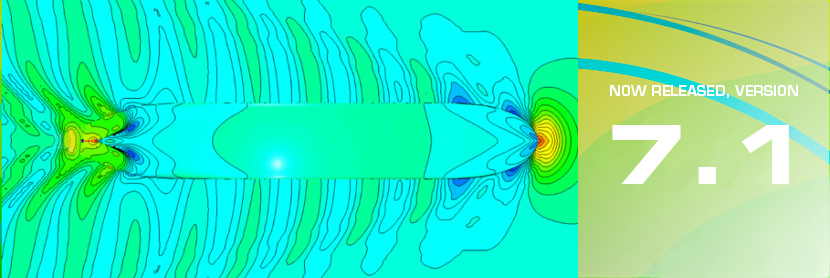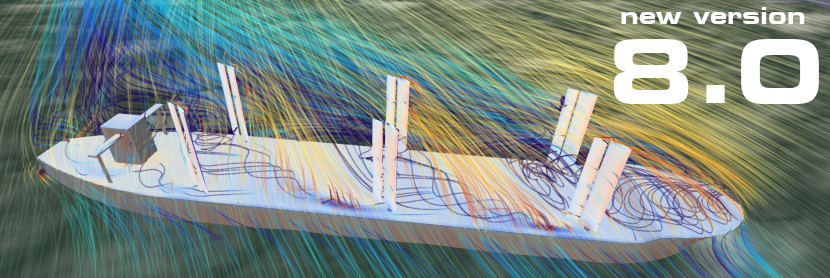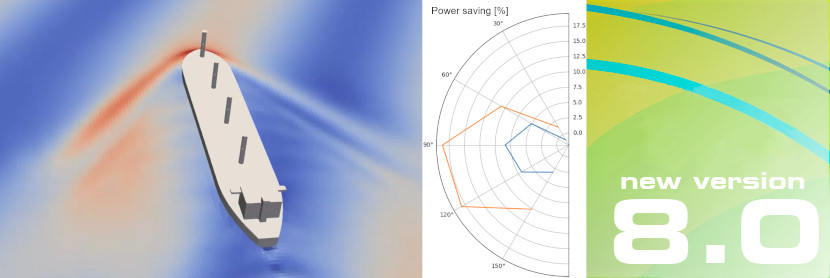SHIPFLOW 8.0 released!
SHIPFLOW 8.0
We are happy to announce that the new major release of SHIPFLOW, version 8.0, is now available for download. The new Multi-Fidelity CFD simulation software is more capable then ever and introduces the following improvements:
NEW APPLICATIONS
• Multi-Fidelity simulations for performance prediction of wind assisted vessels
• Aerodynamics of ships and wind propulsion simulations with RANS
• Virtual Captive Test and manoeuvring derivatives for free sailing simulations
RANS
• New flexible grid generator for hulls
• Substantial update to the Overlapping Grids algorithm. More robust and accurate for complex geometries
MOTIONS
• Wind propulsors with interaction models for Multi-fidelity simulations
• Steady and unsteady atmospheric boundary layer wind models
• External controller module interface for dynamic ship control
• Calculation of vertical, horizontal and torsional bending moments in calm water and in waves
For more details see the Release Notes.
Validation of full-scale delivered power CFD simulations
A new paper published in Ocean Engineering Journal:
Michal Orych, Sofia Werner, Lars Larsson, 2021. Validation of full-scale delivered power CFD simulations. Volume 238, 15 October 2021, 109654
https://www.sciencedirect.com/science/article/pii/S0029801821010301
Abstract:
Verification and Validation of CFD simulations of delivered power at full-scale are carried out for a single screw cargo vessel. Numerical simulations are performed with a steady-state RANS method coupled with a body force propeller model based on a lifting line theory. There are no significant differences in the uncertainty levels between model and full-scale computations. The finest grid exhibits the numerical uncertainty of 1.40% at full-scale. Computed results are compared with sea trial data for three sister ships. Special attention is paid to the effect of roughness on the hull and propeller. The comparison error for the delivered power is about 1% which is significantly lower than the experimental uncertainty.
Keywords:
Delivered power; Full-scale; Hull roughness; Self-propulsion; Uncertainty; Validation; Verification; CFD
Improved methods for design of ships
"Improved digital tools for the hydrodynamic design of energy efficient ships – validation, demonstration and introduction to the maritime industry"
FLOWTECH has just successfully finished a project executed with support from the Swedish Energy Agency (Energimyndigheten). The results of the work include the following:
- Verification and Validation of CFD simulations of delivered power at full-scale were carried out for ships for which high-quality sea-trial data was collected. Special attention was paid to the effect of roughness on the hull and propeller to improve the accuracy of the simulations. The comparison error for the delivered power was about 1% which shows that the simulations at full scale can very accurately predict power demands of new ships as well as ships in service.

- The study performed within this project showed that the numerical optimization of ship hulls at full-scale could yield higher gains in power savings. The presented optimization process included the propeller-hull interactions, and a clear advantage of self-propulsion-based optimization was observed.
- An efficient and accurate numerical procedure to estimate the decrease of ship speed in wind and waves was developed. It was used to calculate the weather factor of the attained energy efficiency design index for new ships, EEDI, for a tanker. The predictions were compared to the model test results and a database of similar ships. The comparison error was 1% for the resistance and the predicted weather factor was in line with the database values.

- Materials with examples and analyses of the project results illustrating the new possibilities for developing energy-efficient hull shapes were prepared. Several papers for scientific journals were written and the resulst will be presented in the upcoming conferences and workshop on numerical ship hydrodynamics. The results will also be shared with the shipyards and design offices through the company network.






